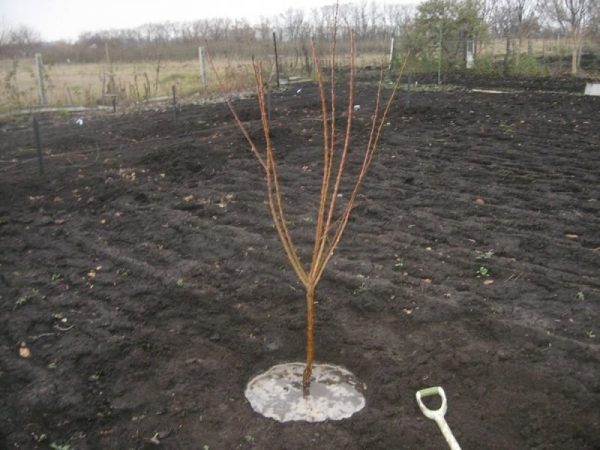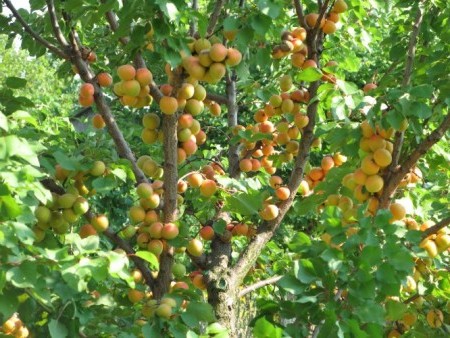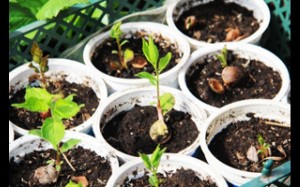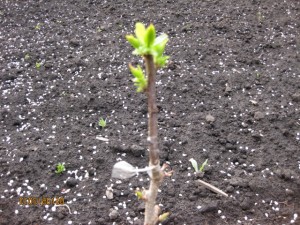The content of the article:
- Where is the best place to plant apricot?
- Planting and caring for apricots.
- Growing apricot from seed.
 Where is the best place to plant apricots?
Where is the best place to plant apricots?
Location.
Apricots are light-loving, undemanding to soil conditions, and grow best in deep, well-aerated soils containing lime. They are drought and wind resistant, avoid stagnation of moisture and salinity, and grow quickly. The site must be protected from north winds.Lowlands where cold air flows are unsuitable for planting.
Choose a sunny place for growing: apricots need to get as much heat as possible during the summer, this will help them survive the winter safely.
When to plant.
It is best to plant apricot, like other stone fruits, in the spring, before the buds swell (usually in April). On the contrary, autumn plantings of stone fruit crops often freeze out, especially in winters with little snow, due to insufficient development of the root system to survive the winter.
Planting material.
For planting, as a rule, standard branched annuals are used, in which single branches (lateral branches) are evenly distributed along the trunk and in space, and are also well subordinate to the continuation shoot (conductor).
Seedlings with branches from adjacent buds and with sharp branching angles are unsuitable for planting. In the future, such branches break off under the weight of the fruit, which leads to the death of the trees. This is also facilitated by the active development of diseases on wound surfaces.
Planting and caring for apricots
Planting seedlings.
The apricot planting pattern is 5 x 5 m, the crown is usually formed round. About two to three weeks before planting, you should prepare a planting hole 40-50 cm deep and 60-80 cm wide and fill it with fertile soil mixed with fertilizer (1-2 buckets of manure, 400-500 g of potassium sulfate and 500- 700 g granulated superphosphate).
During planting, the root collar of the seedling should be located 5-7 cm above the soil surface (after watering, the soil will settle, so the root collar will be at soil level). After planting, you need to form a hole for watering and a roller around its circumference, then water it generously (1-2 buckets of water per 1 tree).
Even in cold and rainy weather, watering is mandatory, since abundantly moistened soil fills the voids between the roots and promotes good survival of the seedling.
Caring for seedlings.
In the first two years, and no more, the planting site (trunk circle) is kept under mulch. A longer stay of the soil under mulch leads to shallow placement of roots in the soil. Semi-rotted manure, sawdust, peat and other organic materials can be used as mulch. It is important to loosen the soil in a timely and careful manner, preventing the strong development of weeds and damage to the roots.
Caring for apricot seedlings includes watering and fertilizing. It is not necessary to form a crown on seedlings; the crown will form by itself. With good care in the first years, an apricot tree grows more than 1 m per year. To prevent the branches from being exposed, 1/3 of the growth is cut off. With the beginning of regular fruiting, rapid growth stops.
In the future, you only need to remove dried and broken branches.
Watering.
Despite its drought resistance, growing apricots is impossible without watering. He suffers from dry air and hot winds. The first watering is as early as possible, before flowering. This has a great influence on the development of the tree, increases the number of ovaries, and creates a supply of moisture for the flowering period.
A second watering is needed after flowering. During the phase of active growth and ripening of fruits, watering improves their taste and promotes the accumulation of sugars.
Stop watering in mid-August. Pre-winter and autumn watering of apricots is not recommended, as it can prolong the growing season and the trees will go into winter unprepared.
To grow good apricots, the seedlings must be carefully looked after and fed.
Feeding.
Apricot trees develop well if there is enough nitrogen, phosphorus, potassium, and microelements in the soil. Nitrogen (especially excess) prolongs the period of vegetative growth, potassium shortens it, phosphorus accelerates the formation of flower buds. Nitrogen-phosphorus fertilizer increases the number of ovaries. Phosphorus-potassium reduces acidity, increases the content of vitamins in fruits, and improves their color.
It is recommended to carry out three mineral fertilizations during the growing season: in early June - with nitrogen fertilizers, in early July - with nitrogen-phosphorus-potassium fertilizers, in early August - with phosphorus-potassium fertilizers.
In the first year, add 1 bucket of water from 1 tbsp. spoon of fertilizer. In subsequent years, the dose is doubled. From the fruiting period, they fertilize and feed depending on the harvest. Organic fertilizers are applied after 10 years of age, otherwise the tree will become “greasy” and freeze.
The apricot tree grows relatively quickly, but the age of fruiting occurs 5-7 years after planting. However, with proper care and if young trees are not replanted, the tree can begin to bloom in 3-4 years.
Growing apricot from seed
For planting, it is best to take seeds from apricots growing in your area. Then the trees turn out to be more unpretentious, adapted to the local climate and soil characteristics.
Parental qualities when growing apricots from stones are rarely inherited. However, stone fruits often produce seedlings that are superior to their parents in fruit size and taste.
Apricot seeds (pits) can be sown at three times.
In summer — immediately after ripening, the seeds of ripe fruits are washed and, without drying, sown.Water during summer and autumn.
Autumn planting is carried out no later than October 10. In this case, the bones should be stored in damp sand in the refrigerator. You can dry them in the shade or indoors without drying them out, put them in a plastic bag and store them at room temperature, and before sowing, soak them in cold water for two days.
For spring When growing seeds, you need to create conditions for a dormant period. On March 8-10, soak them in cold water for 4-5 days, changing it daily. Then place the seeds in a plastic bag with several holes with wet, washed sand or sawdust (1:3) and put in the refrigerator (temperature plus 2-12 degrees). Stratification of apricot seeds lasts from 40 to 100 days, depending on the variety and degree of seed ripening.
At the end of this period, the seed cracks and the seed begins to germinate. It's time to sow (early May). If the seeds hatched earlier, you need to transfer them to a place with a lower temperature (0 minus 2). By the way, this will also stimulate the development of seedlings.
Planting and caring for seedlings.
The bed for sowing seeds is placed in a lighted place, the soil is enriched with humus and complex mineral fertilizers.
The seeding depth is 6-7 cm, the distance between seeds is 10x50 cm. The furrows are watered abundantly before sowing. After planting, the bed is mulched with humus or compost. Even before the shoots appear, the bed is loosened, weeded, and watered regularly.
During the summer, 1-2 times (at the end and in mid-July) they are fed with urea or an infusion of mullein or bird droppings.
Over the summer, with proper care, apricots have time to grow well and next spring they can be transplanted to a permanent place.Caring for apricot trees that were grown from ordinary seeds is actually easier, because they are characterized by increased unpretentiousness and can bear fruit remarkably even on infertile land.






 CUCUMBERS NEVER GET SICK, I'VE BEEN USING ONLY THIS FOR 40 YEARS! I SHARE A SECRET WITH YOU, CUCUMBERS ARE LIKE THE PICTURE!
CUCUMBERS NEVER GET SICK, I'VE BEEN USING ONLY THIS FOR 40 YEARS! I SHARE A SECRET WITH YOU, CUCUMBERS ARE LIKE THE PICTURE! You can dig a bucket of potatoes from each bush. Do you think these are fairy tales? Watch the video
You can dig a bucket of potatoes from each bush. Do you think these are fairy tales? Watch the video
 How our fellow gardeners work in Korea. There is a lot to learn and just fun to watch.
How our fellow gardeners work in Korea. There is a lot to learn and just fun to watch. Eye trainer. The author claims that with daily viewing, vision is restored. They don't charge money for views.
Eye trainer. The author claims that with daily viewing, vision is restored. They don't charge money for views. A 3-ingredient cake recipe in 30 minutes is better than Napoleon. Simple and very tasty.
A 3-ingredient cake recipe in 30 minutes is better than Napoleon. Simple and very tasty. Therapeutic exercises for cervical osteochondrosis. A complete set of exercises.
Therapeutic exercises for cervical osteochondrosis. A complete set of exercises. Which indoor plants match your zodiac sign?
Which indoor plants match your zodiac sign? What about them? Excursion to German dachas.
What about them? Excursion to German dachas.